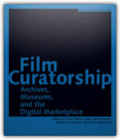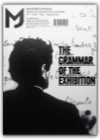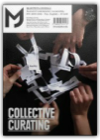A Brief History of Curating
Lucy Lippard, Hans Ulrich Obrist
Part of JRP|Ringer's innovative Documents series, published with Les Presses du Reel and dedicated to critical writings, this publication comprises a unique collection of interviews by Hans Ulrich Obrist mapping the development of the curatorial field—from early independent curators in the 1960s and 70s and the experimental institutional programs developed in Europe and the U.S. through the inception of Documenta and the various biennales and fairs—with pioneering curators Anne D'Harnoncourt, Werner Hoffman, Jean Leering, Franz Meyer, Seth Siegelaub, Walter Zanini, Johannes Cladders, Lucy Lippard, Walter Hopps, Pontus Hulten and Harald Szeemann. Speaking of Szeemann on the occasion of this legendary curator's death in 2005, critic Aaron Schuster summed up, "the image we have of the curator today: the curator-as-artist, a roaming, freelance designer of exhibitions, or in his own witty formulation, a 'spiritual guest worker'... If artists since Marcel Duchamp have affirmed selection and arrangement as legitimate artistic strategies, was it not simply a matter of time before curatorial practice—itself defined by selection and arrangement—would come to be seen as an art that operates on the field of art itself?"
The Culture of Curating and the Curating of Culture
Paul O'Neill
Once considered a mere caretaker for collections, the curator is now widely viewed as a globally connected auteur. Over the last twenty-five years, as international group exhibitions and biennials have become the dominant mode of presenting contemporary art to the public, curatorship has begun to be perceived as a constellation of creative activities not unlike artistic praxis. The curator has gone from being a behind-the-scenes organizer and selector to a visible, centrally important cultural producer. In The Culture of Curating and the Curating of Culture(s), Paul O'Neill examines the emergence of independent curatorship and the discourse that helped to establish it. O'Neill describes how, by the 1980s, curated group exhibitions—large-scale, temporary projects with artworks cast as illustrative fragments—came to be understood as the creative work of curator-auteurs. The proliferation of new biennials and other large international exhibitions in the 1990s created a cohort of high-profile, globally mobile curators, moving from Venice to Paris to Kassel. In the 1990s, curatorial and artistic practice converged, blurring the distinction between artist and curator. O'Neill argues that this change in the understanding of curatorship was shaped by a curator-centered discourse that effectively advocated—and authorized—the new independent curatorial practice. Drawing on the extensive curatorial literature and his own interviews with leading curators, critics, art historians, and artists, O'Neill traces the development of the curator-as-artist model and the ways it has been contested. The Culture of Curating and the Curating of Culture(s) documents the many ways in which our perception of art has been transformed by curating and the discourses surrounding it.
Cultures of the Curatorial
Beatrice von Bismarck, Jorn Schafaf
Curating and the Educational Turn
Daniel Buren, Charles Esche, Paul O'Neill, Mick Wilson
In recent years there has been increased debate on the incorporation of pedagogy into curatorial practice-on what has been termed "the educational turn" ("turn" in the sense of a paradigmatic reorientation, within the arts). In this new volume, artists, curators, critics and academics respond to this widely recognized turn in contemporary art. Consisting primarily of newly commissioned texts, from interviews and position statements to performative text and dialogue, Curating and the Educational Turn also includes a number of previously published writings that have proved primary in the debate so far. Companion to the critically acclaimed Curating Subjects, this anthology presents an essential question for anyone interested in the cultural politics of production at the intersections of art, teaching and learning. Contributors include David Aguirre, Dave Beech, Cornford & Cross, Charles Esche, Liam Gillick, Tom Holert and Emily Pethick.
Everything You Always Wanted to Know About Curating* But Were Afraid to Ask
Hans Ulrich Obrist, April Elizabeth Lamm
Everything you ever wanted to know about Hans Ulrich Obrist but were afraid to ask has now been asked, revealing the truth from the beginning of his career as a young curator in his Zurich kitchen to his recent position as co-director of the Serpentine in London. This book is a ''production of reality conversations,'' otherwise known as interviews. It undertakes the impossible: pinning down this peripatetic curator, and affirming the wisdom of an artist who told Obrist ''don't go'' when he contemplated leaving the art world for other fields. Interviews by Jean Max Colard, Robert Fleck, Jefferson Hack, Nav Haq, Sophia Krzys Acord, Brendan McGetrick, Ingo Niermann, Paul O'Neill, Philippe Parreno & Alex Poots, Juri Steiner, Gavin Wade, et al.
Film Curatorship: Museums, Curatorship and the Moving Image
Paolo Cherchi Usai, David Francis, Alexander Horwath, Michael Loebenstein
What are the major issues and challenges film archives, cinémathèques and film museums are bound to face in the Digital Age and at a time when there is an expectation of Access on Demand?
Film Curatorship neither offers a scholarly analysis, nor attempts to provide definitive answers to a complex situation involving aesthetic as well as technological, economic and political issues. As a collective text, a montage of dialogues, conversations and exchanges between four professionals representing three generations of film archivists and curators, this book calls for an open philosophical and ethical debate on fundamental questions the profession must come to terms with. What is curatorship, and what does it imply in the context of film preservation and presentation? Is there a concept of the "film artifact" that transcends the idea of film as "content" or "art" in the information age?
The four authors of Film Curatorship have agreed to lay bare their concerns, visions, and strategies in a multi-faceted brainstorming session, aimed at fostering an open, non-dogmatic debate on the relationship of film to other forms of moving image and its presentation and preservation in the 21st century.
How to Look At Art-Talk: How to Look At Aesthetics, How to Look At Capital
Jonas Ekeberg
Manifesta Journal
Boris Groys, Okwui Enwezor, Francesco Bonami, Rosa Martinez, Isabel Carlos, Michele Robecchi, Udo Kittelman, Nicolas Bourriaud, Viktor Misiano, Igor Zabel
In 2008 Manifesta Foundation together with Italian publisher Silvana Editoriale made available a reprint of the Manifesta Journal in the form of two books. Initially the single Manifesta Journals were published between 2003 to 2005 in a series of six issues. The first book is composed of the following MJs : MJ#1 The Revenge of the White Cube? (Spring / Summer 2003), MJ#2 Biennials (Winter 2003 / Spring 2004) and MJ#3 Exhibition as a Dream (Spring / Summer 2004).
Manifesta Journal 7 2009/2010 Grammar Of The Exhibition
Various
The Grammar of the Exhibition Manifesta Journals new series on contemporary curatorship starts with an inquiry into the fundamental aspects of curating - namely the grammar of the exhibition. In this context, grammar can be defined as the linguistics and vocabulary of curating, and can also be considered an accepted methodology to help interpret and define the ideas, decisions and actions of the curator. Subdivided in various sections, a differentiated group of authors has been invited to contribute to MJ#.
Manifesta Journal 8: 2009/2010
Various
Manifesta Journal 9 2009/2010
Various
Manifesta Journal 11 2010/2011 Canon Of Curating
Various
Manifesta Journal Vol 4, 5, 6
Robert Fleck, Richard Wood, Natasa Petresin, Francesco Manacorda, Jens Hoffmann, Barbara Steiner, Michele Robecchi, Hans Ulrich Obrist, Viktor Misiano, Igor Zabel
In 2008 Manifesta Foundation together with Italian publisher Silvana Editoriale made available a reprint of the Manifesta Journal in the form of two books. Initially the single Manifesta Journals were published between 2003 to 2005 in a series of six issues. The second book contains MJ#4 Teaching Curatorship (Autumn / Winter 2004), MJ#5 Artist & Curator and Archive (Spring / Summer 2005, first published in this book) and MJ#6 Memory of the Show (Autumn / Winter 2005, first published in this book).
Mj Manifesta Journal: Ethics 12
Rotterdam Dialogues: The Critics, the Curators, the Artists
Zoe Gray, Miriam Kathrein, Nicolaus Schafhausen, Monika Szewczyk, Ariadne Urlus
This book documents three large-scale symposia at Witte de With Center for Contemporary Art. Structured to establish a lively platform for debate and exchange, these symposia explore the practice of three of the protagonists of the contemporary art world: the critic, the curator and the artist. Are they still the people who decide what art is made, what is seen, and whether it is ''good''? The book includes transcripts from workshops and dialogues, and also contains spirited contributions that arrived from participants in the months after the dialogues took place. Bringing together the cross-generational experience of the attendees, this compendium offers insights from some of the most renowned and promising figures in their fields.
Seven Days in the Art World
Sarah Thornton
Named one of the best art books of 2008 by The New York Times and The Sunday Times [London]: “An indelible portrait of a peculiar society.”—VogueThe art market has been booming. Museum attendance is surging. More people than ever call themselves artists. Contemporary art has become a mass entertainment, a luxury good, a job description, and, for some, a kind of alternative religion.
In a series of beautifully paced narratives, Sarah Thornton investigates the drama of a Christie's auction, the workings in Takashi Murakami's studios, the elite at the Basel Art Fair, the eccentricities of Artforum magazine, the competition behind an important art prize, life in a notorious art-school seminar, and the wonderland of the Venice Biennale. She reveals the new dynamics of creativity, taste, status, money, and the search for meaning in life. A judicious and juicy account of the institutions that have the power to shape art history, based on hundreds of interviews with high-profile players, Thornton's entertaining ethnography will change the way you look at contemporary culture. 8 illustrations
미술과 정치적인 것의 가장자리에서
김장언 지음
위대한 전시는 어떻게 탄생하는가? - 최고의 큐레이터들이 답하다
폴라 마린콜라 엮음, 조주현 옮김
전시의 담론 - 모더니즘 이후 미술의 화두 2
윤난지 엮음
큐레이팅의 역사
한스 울리히 오브리스트 지음, 송미숙 옮김
큐레이팅이란 무엇인가
폴 오닐 엮음, 변현주 옮김
파워 오브 디스플레이 - 20세기 전시 설치와 공간 연출의 역사
메리 앤 스타니스제프스키 지음, 김상규 옮김
|



























 Made with Delicious Library
Made with Delicious Library